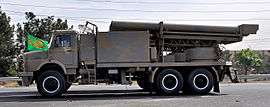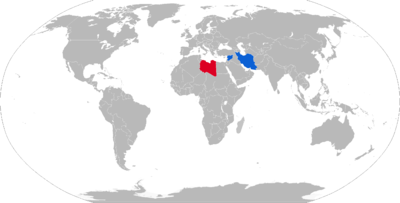Fajr-5
| Fajr-5 | |
|---|---|
 | |
| Type | Rocket artillery |
| Place of origin |
|
| Service history | |
| Used by |
|
| Wars |
2006 Lebanon War |
| Production history | |
| Designed | Said to have started after late 1980s/early 1990s |
| Manufacturer | Aerospace Industries Organization, Sanam Industrial Group, Defense Industries Organization[1][2] |
| Specifications | |
| Weight |
1,500 kg (System) 90 kg (HE Content) 175 kg (Warhead) 915 kg (Rocket)[3] |
| Length |
10.45 m (Launcher) 6.485 m (Rocket)[3] |
| Width | 2.54 m (Launcher)[3] |
| Height |
3.34 m (Launcher)[3] |
|
| |
| Caliber | 333 mm |
| Elevation | 0 to 57 degrees[3] |
| Traverse | 45 degrees left and right[3] |
| Rate of fire | 4–8 seconds[3] |
| Effective firing range | 68–75 km |
|
| |
| Speed | 1009m/s |
The Fajr-5 (Persian: فجر-۵, meaning "dawn-5") is an artillery rocket developed by Iran in the 1990s. The system is part of the Fajr family of rockets.
Overview
The latest production of the Fajr-5 is installed on a new 6 × 6 forward control chassis[4] and the platform is now integrated into a complete weapon system rather than an individual launcher. To provide a more stable firing platform four hydraulically operated stabilizers are lowered to the ground before firing. The new chassis has improved cross-country mobility and the forward control fully enclosed cab provides space for the driver and two passengers. Another fully enclosed cabin to the immediate rear of the cab houses the remainder of the crew. The new Mercedes-Benz chassis is similar to that manufactured in China, which is used as the basis for the Norinco (China North Industries Corporation) 122 mm (40-round) Type 90 ARS. While the primary role of this artillery rocket system is the engagement of land targets, AIO says that a radar can be added to give the system the capability to track and engage naval targets. The Fajr-5 missile, which is launched from a mobile platform, reportedly has a range of 75 kilometers (50 mi). Also a two-stage version of the rocket is reported to be produced with a length of 9 m and range of 190 km. But this variant is launched from TELs similar to Zelzal missiles which only has the capacity for a single rocket.
History
The first Fajr-5 were created when China exported WS-1 MLRS to Iran in the late 1980s/early 1990s.[5] They were then subsequently created and produced by Iran's Aerospace Industries Organization. In May 2006, Iran's Aerospace Industries Organization (AIO) has developed an upgraded version of the well-established Fajr-5 333 mm (4-round) unguided surface-to-surface artillery rocket system (ARS).[6]
Combat record
Iran was reported to have supplied a number of these rockets to Hezbollah forces in Lebanon in 2006.[7]
- During the 2006 Lebanon War Hezbollah militants fired rockets deeper into Israel than in past conflicts. Hezbollah called these rockets the Khaibar-1.[8] Israeli police bomb experts believed the rockets to be an enhanced version of the Fajr-5.[9]
- In November 2012 during Operation Pillar of Defense, Hamas and Palestinian Islamic Jihad fired Fajr-5 rockets towards Tel Aviv and Jerusalem. One hit an apartment block in Rishon LeZion. The commander of the Iranian Guard said that Iran did not supply Gaza with a Fajr-5 missile but transferred the technology to manufacture it to the Palestinians.[10]
Operators

Current operators
Former Operators
See also
References
- ↑ Aerospace Industries Organization. Retrieved on May 13, 2008.
- ↑ It is assumed that AIO is responsible for Fajr-5's production since nti.org claims that AIO is responsible for producing missiles of all types except ballistic missiles.
- 1 2 3 4 5 6 7 Fajr-3 & Fajr-5 brochure. Retrieved on May 13, 2008.
- ↑ Fadjr-5. Retrieved on May 12, 2008.
- ↑ Vital Perspective: North Korea. Retrieved on May 12, 2008.
- ↑ Foss, Christopher F (2006-05-08). "Fadjr-5 artillery rocket system gets new chassis". Jane's Information Group. Archived from the original on 2006-06-14. Retrieved 2006-07-30.
- ↑ "Le Hezbollah tire des missiles "au-delà de Haïfa" alors que les raids aériens israéliens s'intensifient". Le Monde. 2006-07-29.
- ↑ Gannon, Kathy (2006-07-28). "Hezbollah Fires New Rockets Into Israel". Associated Press. Archived from the original on June 29, 2011. Retrieved 2006-07-30.
- ↑ Roffe-Ofir, Sharon (2006-07-28). "Fajr-5 missiles fired at Israel". YNet. Retrieved 2006-07-30.
- ↑ http://tehrantimes.com/politics/103510-iran-transferred-fajr-5-missile-technology-to-gaza-irgc-chief-
- ↑ http://articles.janes.com/articles/Janes-Missiles-And-Rockets-2004/Iran-supplies-improved-rockets-to-Syria-and-Hizbullah.html
- ↑ Fajr-5 missile gives Palestinians rare if short-lived advantage November 16, 2012